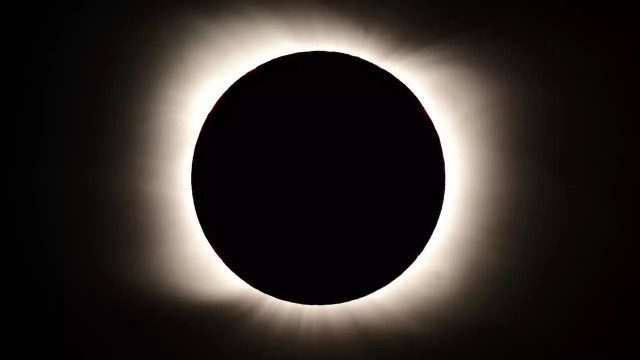Solar eclipse plunges parts of Chile, Argentina into darkness for two minutes
In Mapuche culture, an eclipse signifies temporary death of the sun

A solar eclipse that lasted around two minutes plunged southern Chile and Argentina into darkness on Monday.
Heavy rain had threatened to prevent thousands of stargazers in Chile from seeing the eclipse but at the last moment, the clouds parted just enough for the phenomenon to be partially visible.
"It was beautiful, unique. The truth is that no-one held much hope of seeing it due to the weather and clouds, but it was unique because it cleared up just in time. It was a miracle," an emotional Matias Tordecilla, 18, told AFP from the town of Pucon on the shores of Lake Villarrica.
"It's something that you don't just see with your eyes but also feel with your heart," added Tordecilla, who traveled 10 hours with his family to see the eclipse.
In Argentine Patagonia, several families and foreigners had set up camp between the towns of Villa El Chocon and Piedra del Aguila hoping to see the eclipse.
While there was no rain there, strong winds had threatened to impact the visibility of the second total eclipse for Chile in the last 18 months.
This one struck at 1:00 pm (1600 GMT) as thousands of tourists and residents gathered, hoping the clouds would disappear in time.
"It made my skin crawl," said Pucon resident Cinthia Vega.
Study reveals where the next pandemic could emerge
Despite restrictions on movement imposed by authorities to slow the spread of the coronavirus pandemic, almost 300,000 tourists had arrived in the Araucania region around 800 kilometers (500 miles) south of the capital Santiago.
Dozens of amateur and professional scientists set up telescopes on the slopes of the Villarrica volcano -- one of the most active in Chile -- to observe the phenomenon when the moon passes between the sun and Earth.
The eclipse was due to be visible along a 90-kilometer wide corridor from the Pacific coast in Chile across the Andes mountain range and into Argentina.
In July 2019, some 300,000 people turned out in the Atacama desert in Chile's north, home to several observatories, to see the previous eclipse.
Experience the magic of a total solar eclipse! ☀️🌗🌎
— NASA Goddard (@NASAGoddard) December 14, 2020
On Dec 14, 10:30 am ET, @NASA_es will provide Spanish language coverage of an eclipse that will pass over South America!
https://t.co/Tph43yIDY5 https://t.co/CWdblA8Yax
Chilean authorities had been worried that the eclipse would attract large gatherings of people.
There have been more than 570,000 coronavirus cases amongst the 18 million population with almost 16,000 confirmed deaths.
Strict controls were announced for the areas where the total eclipse would be visible, with free movement banned both the day before and after.
Eclipse significant for the indigenous community
This event was eagerly anticipated amongst Chile's Mapuche indigenous community, the largest such group in the country's south.
Pakistanis lobby for 'AmazoninPakistan' on Twitter
In Mapuche culture, an eclipse signifies the temporary death of the sun during a battle between the star and an evil force known as "Wekufu."
Indigenous people used to worship the sun "like a God," astronomer Jose Maza told AFP last week.
According to indigenous expert Juan Nanculef, the people would light bonfires and launch "stones and arrows into the air" to help the sun in its battle against the Wekufu.
Nanculef actually performed a ritual as the eclipse began to ask nature to bring an end to the rains and make it visible.
"Previously it was 100 percent effective," he said.
This time it seems to have worked just well enough to give people a glimpse of the eclipse.



















COMMENTS
Comments are moderated and generally will be posted if they are on-topic and not abusive.
For more information, please see our Comments FAQ